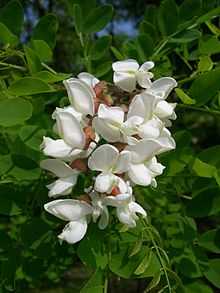Robinioids
| Robinioids | |
|---|---|
 | |
| Robinia pseudoacacia | |
| Scientific classification | |
| Kingdom: | Plantae |
| (unranked): | Angiosperms |
| (unranked): | Eudicots |
| (unranked): | Rosids |
| Order: | Fabales |
| Family: | Fabaceae |
| Subfamily: | Faboideae |
| (unranked): | Hologalegina |
| (unranked): | Robinioids |
| Tribes | |
The robinioids are one of the four major clades (genisitoids, dalbergioids, millettioids and robinioids) in subfamily Faboideae of the flowering plant family Fabaceae (Leguminosae). It is composed of the traditional tribes Loteae, Sesbanieae and Robinieae. It is a large and important clade that is distributed in mostly temperate areas. Species in this clade share a unique determinate root nodule structure.
History
Only two tribes (Loteae and Robinieae) were traditionally included in clade robinioids. Lavin & Schrire later included Sesbanieae into clade robinioids.[1] Tribe Robinieae is primarily in tropical and arid temperate areas, containing mostly trees and shrubs of New World. Tribe Loteae are herbaceous and small shrubby legumes closely related with Old World tribe Galegeae.[2]
Loteae was originally a smaller group of legumes until later in 1994 Polhill merged Loteae and tribe Coronilleae and greatly expanded Loteae.[3] Sesbanieae is a tribe with single genus Sesbania, which was originally placed under tribe Robinieae.
Systematics
Loteae and Robinieae are traditionally grouped under clade robinioids: these two major groups are primarily found in Europe, North America, and South America.[1][3] Sesbanieae was a group included in 2005.[1]
Monophyly:
Monophyly of tribe Loteae: molecular data have shown support for monophyly with the exception for New World Lotus. Monophyly of Old World Lotus is moderately supported whereas New World Lotus is considered as paraphyletic.[4]
Monophyly of tribe Robinieae and Sesbanieae is strongly supported. Sesbanieae only has one genus Sesbania.
Intratribal relationship: Sesbanieae is either sister to Loteae, or sister to the rest of clade robinioids.[5][6]
References
Bibliography
- Polhill, R. M. (1994). Classification of the Leguminosae. Pages xxxv–xlviii in Phytochemical Dictionary of the Leguminosae (F. A. Bisby, J. Buckingham, and J. B. Harborne, eds.). Chapman and Hall, New York, NY.
- Lavin M. and Schrire B. D. (2005). Sesbanieae. Pages 452-453 in Legumes of the world (Lewis et al., eds.). Royal Botanic Gardens, Kew, UK.
- Lavin M. and Schrire B. D. (2005). Robinieae. Pages 467-473 in Legumes of the world (Lewis et al., eds.). Royal Botanic Gardens, Kew, UK.
- Allan G. J., Zimmer E. A., Wagner W. L. and Sokoloff D. D.. (2003). Molecular phylogenetic analyses of tribe Loteae (Leguminosae): implications for classification and biogeography. Pages 371-393 in Advances in legume systematics, part 10: higher level systematics (B.B. Klitgaard and A. Bruneau, eds.). Royal Botanic Gardens, Kew, UK.
- Wojciechowski M. F., Sanderson M. J., Steele K. P. and Liston A. (2000). Molecular phylogeny of the “temperate herbaceous tribes” of papilionoid legumes: a supertree approach. Pages 277-298 in Advances in Legume Systematics, part 9 (P. S. Herendeen and A. Bruneau, eds.). Royal Botanic Gardens, Kew, UK.
- Dormer, K.J. (1945). An investigation of the taxonomic value of shoot structure in angiosperms with especial reference to Leguminosae. Ann. Bot., n.s. 9: 141-153.